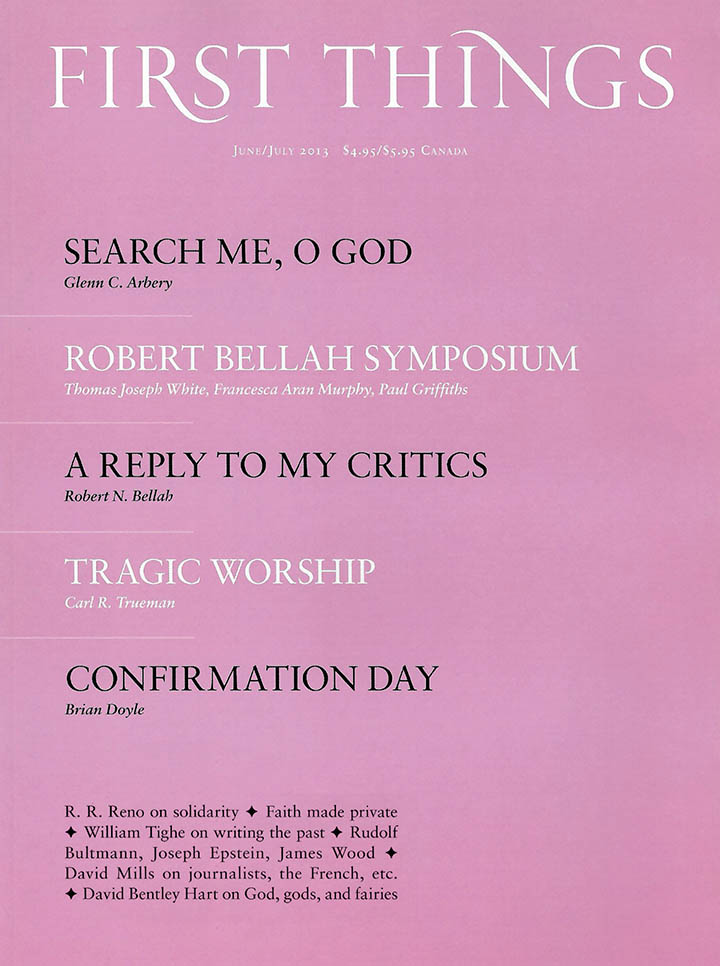
The problem with much Christian worship in the contemporary world, Catholic and Protestant alike, is not that it is too entertaining but that it is not entertaining enough. Worship characterized by upbeat rock music, stand-up comedy, beautiful people taking center stage, and a certain amount of Hallmark Channel sentimentality neglects one classic form of entertainment, the one that tells us, to quote the Book of Common Prayer, that “in the midst of life we are in death.”
It neglects tragedy. Tragedy as a form of art and of entertainment highlighted death, and death is central to true Christian worship. The most basic liturgical elements of the faith, baptism and the Lord’s Supper, speak of death, of burial, of a covenant made in blood, of a body broken. Even the cry “Jesus is Lord!” assumes an understanding of lordship very different than Caesar’s. Christ’s lordship is established by his sacrifice upon the cross, Caesar’s by power.
Perhaps some might recoil at characterizing tragedy as entertainment, but tragedy has been a vital part of the artistic endeavors of the West since Homer told of Achilles, smarting from the death of his beloved Patroclus, reluctantly returning to the battlefields of Troy. Human beings have always been drawn to tales of the tragic, as to those of the comic, when they have sought to be lifted out of the predictable routines of their daily lives—in other words, to be entertained.
From Aeschylus to Tennessee Williams, tragedians have thus enriched the theater. Shakespeare’s greatest plays are his tragedies. Who would rank Charles Dickens over Thomas Hardy and Joseph Conrad? Tragedy has absorbed the attention of remarkable thinkers from Aristotle to Hegel to Terry Eagleton.
Christian worship should immerse people in the reality of the tragedy of the human fall and of all subsequent human life. It should provide us with a language that allows us to praise the God of resurrection while lamenting the suffering and agony that is our lot in a world alienated from its creator, and it should thereby sharpen our longing for the only answer to the one great challenge we must all face sooner or later. Only those who accept that they are going to die can begin to look with any hope to the resurrection.
Yet today tragedy has, with few exceptions, dropped from popular entertainment. Whether it is the sentimentalism of the Hallmark Channel, the pyrotechnics of action movies, or the banal idiocy of reality TV, the tragic sensibility is all but lost. This is further compounded by the trivial way in which the language of tragedy is now used in popular parlance. As with defining moment and crisis, the words tragedy and tragic are now expected to perform Stakhanovite levels of linguistic labor. In a world where even sporting defeats can be described as tragedies, rarely do the terms speak of the catastrophic moral crises and heroic falls that lie at the heart of great tragic literature.
Yet human life is still truly tragic. Death remains a stubborn, omnipresent, and inevitable reality. For all of postmodern anti-essentialism, for all the repudiation of human nature, for all the rhetoric of self-creation, death eventually comes to all, frustrates all, levels all. It is not simply a linguistic construct or a social convention. Yet despite this, Western culture has slowly but surely pushed death, the one impressive inevitability of human life, to the very periphery of existence.
Pascal observed the problem in seventeenth-century France when he saw the obsession with entertainment as the offspring of the fallen human desire to be distracted from any thought of mortality. “I have often said that the sole cause of man’s unhappiness is that he does not know how to stay quietly in his room,” he said. And: “Distraction is the only thing that consoles us for miseries, and yet it is itself the greatest of our miseries.”
Today the problem is even greater: Entertainment has apparently become many people’s primary purpose of existence. I doubt that it would surprise Pascal that the world has increased the size, scope, and comprehensiveness of distraction. It would not puzzle him that death has been reduced to little more than a comic-book cartoon in countless action movies or into a mere momentary setback in soap operas and sitcoms. Indeed, he would not find it perplexing that the bleak spiritual violence of mortality leaves no lasting mark on the bereaved in the surreal yet seductive world of popular entertainment.
But he might well be taken aback that the churches have so enthusiastically endorsed this project of distraction and diversion. This is what much of modern worship amounts to: distraction and diversion. Praise bands and songs of triumph seem designed in form and content to distract worshipers from life’s more difficult realities.
Even funerals, the one religious context where one might have assumed the reality of death would be unavoidable, have become the context for that most ghastly and incoherent of acts: the celebration of a life now ended. The Twenty-Third Psalm and “Abide with Me” were funeral staples for many years but not so much today. References to the valley of the shadow of death and the ebbing out of life’s little day, reminders both of our mortality and of God’s faithfulness even in the darkest of times, have been replaced as funeral favorites by “Wind Beneath My Wings” and “My Way.” The trickle down economics of worship as entertainment has reached even the last rites for the departed.
Yet tragedy is a vital part of entertainment. Aristotle in his Poetics famously argued for the personal and social benefits of tragic drama. The audience, swept up into the vertiginous moral crises, the magnificent flaws, and the catastrophic falls of the heroes, enjoyed the experience of catharsis—running the gamut of relevant emotions—without being agents in the events depicted on the stage. They left the theater cleansed by the experience and knowing more deeply what it means to be human. They were wiser, more thoughtful, and better prepared to face the reality of their own lives.
Of all places, the Church should surely be the most realistic. The Church knows how far humanity has fallen, understands the cost of that fall in both the incarnate death of Christ and the inevitable death of every single believer. In the psalms of lament, the Church has a poetic language for giving expression to the deepest longings of a humanity looking to find rest not in this world but the next. In the great liturgies of the Church, death casts a long, creative, cathartic shadow. Our worship should reflect the realities of a life that must face death before experiencing resurrection.
It is therefore an irony of the most perverse kind that churches have become places where Pascalian distraction and a notion of entertainment that eschews the tragic seem to dominate just as comprehensively as they do in the wider world. I am sure that the separation of church buildings from graveyards was not the intentional start of this process, but it certainly helped to lessen the presence of death. The present generation does not have the inconvenience of passing by the graves of loved ones as it gathers for worship. Nowadays, death has all but vanished from the inside of churches as well.
In my own tradition, the historic Scottish Presbyterian tradition, the somber tempos of the psalter, the haunting calls of lament, and the mortal frailty of the unaccompanied human voice helped to connect Sunday worship to the realities of life. There are indeed psalms of joy and triumph. The parents rejoicing in the birth of a child could find words of gratitude to sing to the Lord, but there are also psalms which allow bereaved parents to express their grief and their sorrow in words of praise to their God.
The psalms as the staple of Christian worship, with their elements of lament, confusion, and the intrusion of death into life, have been too often replaced not by songs that capture the same sensibilities—as the many great hymns of the past did so well—but by those that assert triumph over death while never really giving death its due. The tomb is certainly empty; but we are not sure why it would ever have been occupied in the first place.
Only the dead can be resurrected. As the second thief on the cross saw so clearly, Christ’s kingdom is entered through death, not by escape from it. Traditional Protestantism saw this, connecting baptism not to washing so much as to death and resurrection. Protestant liturgies made sure that the law was read each service in order to remind the people that death was the penalty for their sin. Only then, after the law had pronounced the death sentence, would the gospel be read, calling them from their graves to faith and to resurrection life in Christ. The congregants thereby became vicarious participants in the great drama of salvation.
There was surely catharsis in such worship: The congregants left each week having faced the deepest reality of their own destinies. Perhaps it is ironic, but the church that confronts people with the reality of the shortness of life lived under the shadow of death prepares them for resurrection better than the church that goes straight to resurrection triumphalism without that awkward mortality bit.
Bonhoeffer once asked, “Why did it come about that the cinema really is often more interesting, more exciting, more human and gripping than the church?” Why, indeed. Maybe the situation is even worse than I have described; perhaps the churches are even more trivial than the entertainment industry. After all, in popular entertainment one does occasionally find the tragic clearly articulated, as in the movies of a Coppola or a Scorsese.
A church with a less realistic view of life than one can find in a movie theater? For some, that might be an amusing, even entertaining, thought; for me, it is a tragedy.


